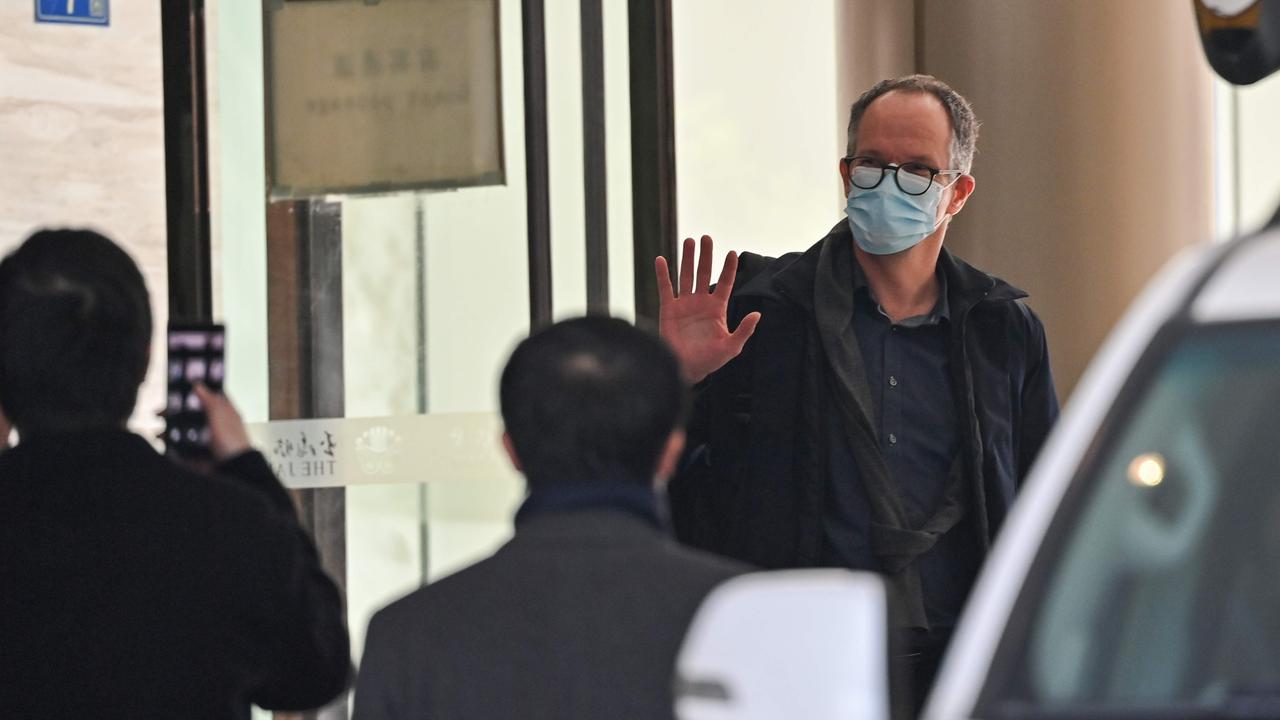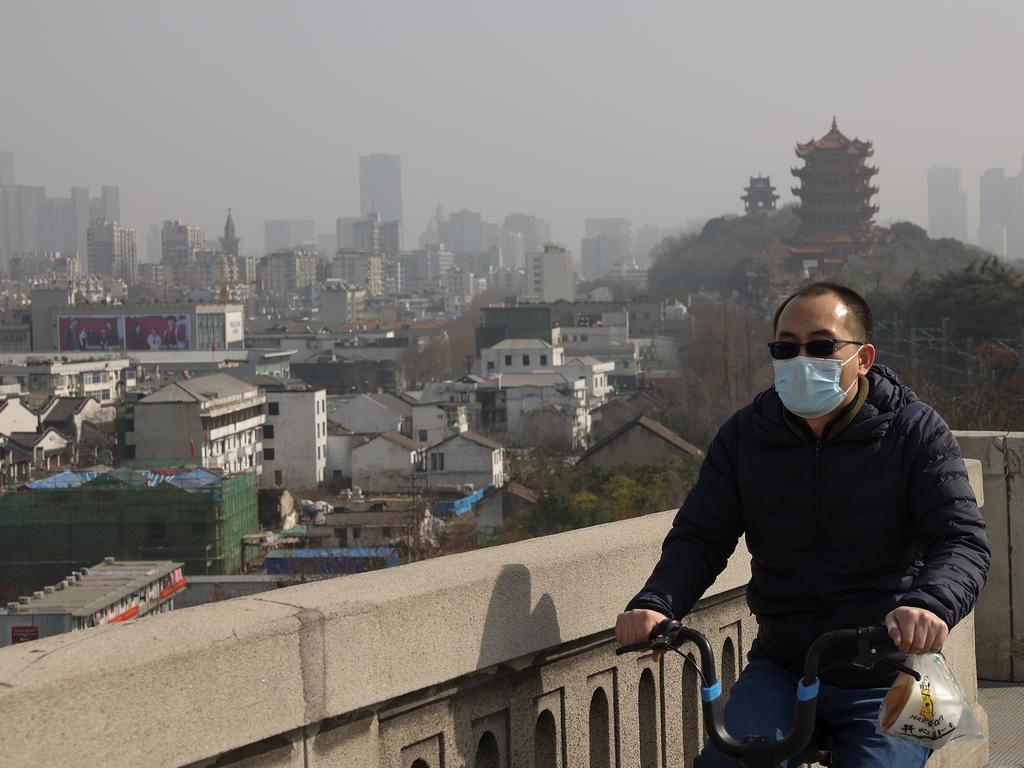COVID-19 in China: WHO experts in Wuhan begin virus origin investigation
A World Health Organisation team has started its probe in China, and one location could be at the heart of what everyone wants to know.

The world is watching as a team of COVID-19 detectives from the World Health Organisation officially entered the Chinese city of Wuhan to investigate inside the infamous origins of the virus.
Much anticipation rests on the shoulders of these 10 researchers but questions remain over just how much access they will receive during their two-week visit in the city where the deadly virus originated in late 2019.
The team were spotted emerging from their two-week hotel quarantine and boarding a bus after undergoing a long series of tests, but their final destination was another “Hilton resort-like” hotel where they will stay during their visit.
Information is expected to released over the next week regarding how much access the team will have to important sites but there are a number of key targets despite restrictions on their movement.
Members said they still weren’t 100 per cent clear on where they will go in the coming days.
RELATED: World’s first ‘proven’ documented case of COVID-19 reinfection
RELATED: White House reveals how Trump dealt with COVID-19 pandemic
RELATED: China trials anal swabbing for high-risk cases

They were seen wearing masks as they faced awaiting media, with the Associated Press’ Emily Wang Fujiyama noting “workers wearing protective outfits and face shields could be seen loading their luggage”.
The bus driver, she said, wore a full-body white protective suit.
The WHO team is out of quarantine in Wuhan and so the investigation can begin. Let’s see what they find pic.twitter.com/OJ8iEJSmYU
— Tom Cheshire (@chesh) January 28, 2021
Day 14 of our quarantine in Wuhan!! Slightly sad to say goodbye to my “gym†& my “office†where I’ve been holed up for last 2 wks!! (Clue - It’s all in the same room...). Moving into next phase of work now w/ @WHO mission team & China counterparts. pic.twitter.com/SC75H70WMK
— Peter Daszak (@PeterDaszak) January 28, 2021
China has continually distanced itself from blame for its response during the early days of the coronavirus outbreak and it has taken WHO months to gain access to China, with authorities in Beijing responsible for much of the team’s itinerary.
“We don’t know if they’re going to have the freedom to move around,” Sky’s Tom Cheshire, in Wuhan, said.
“We don’t know if they’ll visit the Institute of Virology, for instance.”
China’s daily coronavirus cases have continued decline over recent days and now average 102 cases on a seven-day average, but Chinese New Year could halt the countries success.
Tras terminar la cuarentena de dos semanas obligatoria al llegar a #China, pasadas las tres de la tarde salen del hotel los expertos de la OMS que van a investigar el origen del #coronavirus. Asà empieza la misión sobre el terreno en #Wuhan. pic.twitter.com/tW54ypzmFI
— Pablo M. DÃez (@PabloDiez_ABC) January 28, 2021
Earlier this month, former WHO official Keiji Fukuda, warned against expect easy answers, concluding it could be years before any firm decisions could be made on the virus’ origin.
“This is now well over a year past when it all started,” he said. “So much of the physical evidence is going to be gone. The memories of people are imprecise and probably the physical layout of many places are going to be different than they were and how people are moving about and so on.”
But there is hope. While WHO attempts to manage expectations, the sites they may visit include the Huanan Seafood Market, where there is much speculation that “patient zero” first appeared.
The 57-year-old seafood merchant at the wet market, who The Wall Street Journal have identified as a woman named Wei Guixian, first started to feel sick on December 10.
WATCH: Here's the moment the @WHO team emerges from their 14-day quarantine in Wuhan, China to begin an investigation into the origins of #Covid19.
— Bloomberg Quicktake (@Quicktake) January 28, 2021
More: https://t.co/dRqaHy4YnD pic.twitter.com/9NEnzJMOhC
The next phase for the @WHO team in #Wuhan will be field work: hospitals, Huanan market, in-person meetings with Chinese scientists. It’s a tightly-controlled itinerary in a city where the #coronavirus has largely disappeared. Has the trail gone cold? @NBCNews is back in #Wuhan. pic.twitter.com/tEUgztWb5I
— Janis Mackey Frayer (@janisfrayer) January 28, 2021
The common theory is that the virus stemmed from bats in caves in rural Yunnan province, about 1,600 kilometres southwest of Wuhan, and spread to the market, where live, wild animals were sold as food.
Chinese Foreign Ministry spokesperson Zhao Lijian said experts would engage in talks, on site visits and inspections but did not provide further details or insight.
The ABC’s Bill Birtles spoke to Australia’s representative in Wuhan, Dr Dominic Dwyer, who said the experts had already learnt “a remarkable amount” while in hotel quarantine but will only visit sites in “restricted bubble-like quarantine conditions”.
“I still think there’s a scientific and diplomatic dance around access to the data directly, but that’s being negotiated,” Mr Dwyer said.
He said he expected the team will visit hospitals that treated the earliest patients of the pandemic.

In April, Prime Minister Scott Morrison called for an independent inquiry into the origins of the virus, sparking a furious reaction from China, which has since imposed a series of punishing tariffs on Australian trade goods as relations deteriorate.
China has even argued that Western countries could be responsible for bringing the virus into country, suggested it may have arrived via imported frozen food from countries including Australia.
Outside the WHO quarantine hotel stake out in #Wuhan right now. The visiting scientists come out of quarantine today and will move to a “normal†hotel but will still have some restrictions on their movements due to #China’s extra virus prevention measures. pic.twitter.com/y0vmjSxhHB
— Stephen McDonell (@StephenMcDonell) January 28, 2021
The mission is taking on as much political pressure as the overwhelming global demand for answers, with China already trading barbs with the US over the visit.
Mr Lijian fired back at White House press secretary Jen Pskai, who noted the US wanted a “robust and clear probe” into the origins of the COVID-19 pandemic in China.
She said it was “imperative we get to the bottom” of the story of the beginnings to the virus and expressed concern over “misinformation” from Chinese authorities.
China immediately bit back, telling the US to “respect facts and science” and “respect the hard work” of the WHO team.
“They will cause unnecessary interference in the WHO expert group’s scientific research co-operation in China and are not conducive to serious scientific conclusions,” Mr Lijian warned.





